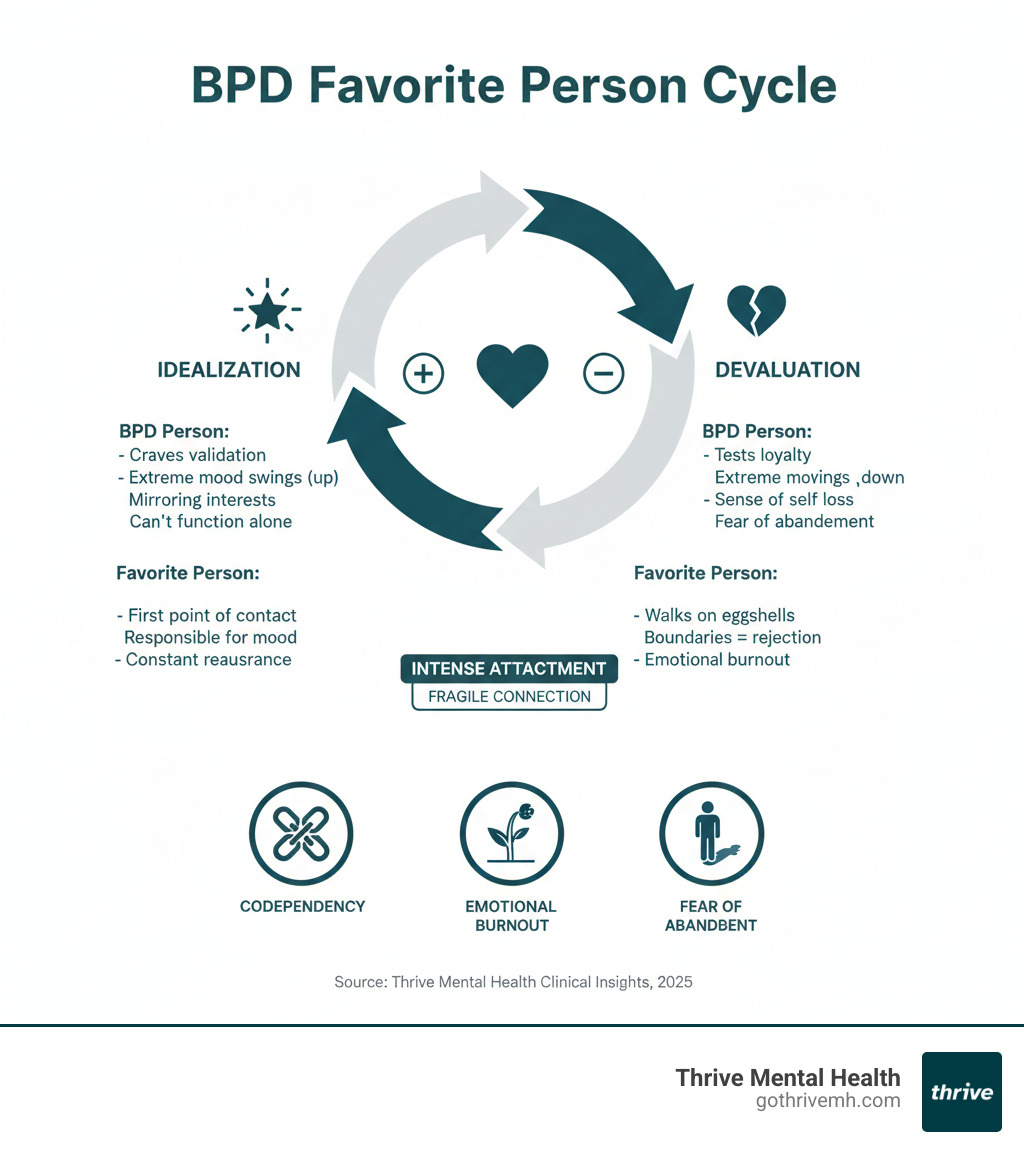A Practical Guide to What It Means to Have a BPD Favorite Person

What It Means to Have a BPD Favorite Person: Master 2025
Understanding the Intense World of BPD Relationships
If you or someone you know is in crisis or struggling with thoughts of self-harm, please call or text the 988 Suicide & Crisis Lifeline. You are not alone, and help is available 24/7.
What it means to have a BPD favorite person is to experience an intense, all-consuming emotional attachment where one individual becomes the primary source of validation, comfort, and identity for someone with Borderline Personality Disorder (BPD). This dynamic, affecting roughly 1.4% of U.S. adults with BPD, is one of the condition’s most challenging aspects.
Quick Answer: Key Signs of a BPD Favorite Person Dynamic
For the person with BPD:
- Craving constant attention and approval from one specific person
- Experiencing extreme mood swings based on that person’s availability
- Testing their loyalty repeatedly
- Losing your sense of self and mirroring their interests
- Feeling unable to function without them
For the favorite person:
- Being the first point of contact for everything
- Feeling responsible for their mood changes
- Providing constant reassurance
- Walking on eggshells to avoid triggering abandonment fears
- Having your boundaries perceived as rejection
The favorite person (FP) relationship is an intense emotional dependency marked by a cycle of idealization (“you’re perfect”) and devaluation (“you’ve betrayed me”), which is exhausting for both people. This pattern often stems from childhood invalidation, making the FP a fragile emotional lifeline.
The good news is that with treatment and boundaries, these relationships can become healthier. I’m Anna Green, LMHC, LPC, Chief Clinical Officer at Thrive Mental Health. I specialize in helping individuals across Florida steer the FP dynamic using evidence-based therapies like Dialectical Behavior Therapy (DBT), focusing on building stable relationships and sustainable boundaries.

What is a BPD Favorite Person (FP) and Why Does It Happen?
A “favorite person” (FP) is the gravitational center of a BPD individual’s emotional world—their primary source of validation, comfort, and even identity. The FP dictates their mood and self-worth. This isn’t a choice; it’s an ingrained pattern rooted in how BPD affects emotional regulation and attachment.

The dynamic is marked by extreme idealization and devaluation, a pattern often called “splitting.” Scientific research on splitting in BPD shows this black-and-white thinking where the FP is either perfect or cruel, making the relationship incredibly unstable. An anxious attachment style fuels this, with a profound fear of abandonment triggering panic and frantic attempts to reconnect over minor perceived slights.
| Feature | BPD-FP Relationship | Healthy, Interdependent Relationship |
|---|---|---|
| Emotional Dependence | High; FP is primary source of emotional regulation | Balanced; Individuals regulate emotions internally, seek support from multiple sources |
| Sense of Self | Often unstable; Mirrors FP’s identity, interests | Stable; Individuals maintain distinct identities |
| Fear of Abandonment | Intense and pervasive, leading to clinginess | Present but manageable; Trust and security mitigate fear |
| Idealization/Devaluation | Frequent “splitting”; All-or-nothing perception of FP | Realistic view of partner, acknowledging strengths and flaws |
| Boundaries | Often porous or violated; Perceived as rejection | Respected and clearly communicated |
| Mood Regulation | Heavily reliant on FP’s presence/approval | Internal and self-managed, with external support as needed |
The Psychological Roots: Trauma and the Need for Validation
The FP attachment often traces back to childhood invalidation—an environment where emotional needs were dismissed or trauma occurred. Research linking childhood maltreatment to BPD confirms this link. Without learning to self-soothe, adults with BPD seek external validation, creating insecure attachment patterns. The FP becomes an attempt at a “corrective” emotional experience, but no single person can fulfill this role, setting both up for crisis. If you’re dealing with unresolved trauma, you can learn how we treat trauma in Florida at Thrive Mental Health.
How an FP Differs From a Best Friend or Partner
The core difference is dependency versus interdependency. In healthy relationships, there’s mutual reliance. With an FP, the person with BPD exhibits extreme dependency, viewing the FP as essential for survival. The FP becomes an external emotional regulator. The person with BPD may also start mirroring the FP—adopting their interests and opinions—out of fear that being themselves will lead to abandonment.
Key Signs of a Favorite Person Dynamic
Recognizing a favorite person dynamic is the first step toward managing these intense relationships. The signs revolve around an emotional urgency that feels all-consuming for both people, marked by constant communication, jealousy, and dramatic mood swings tied to the FP’s perceived actions.

Understanding what it means to have a BPD favorite person requires looking at both sides of this dynamic.
Signs You Have a Favorite Person
If you have BPD, you may need one person in a way that feels desperate.
- You crave their attention and approval: Your self-worth is tied to their validation.
- You’re eager to please them: You might abandon your own wants to avoid disappointing them.
- Your mood depends on them: A delayed text can ruin your day, while a quick message can make it.
- You test their loyalty: You might push them away just to see if they’ll fight to stay, a behavior rooted in a deep fear of abandonment.
- You’re losing your sense of self: You start mirroring their interests, style, and goals to keep them close.
Signs You Are a Favorite Person
Being an FP can feel flattering initially, but it often becomes an unsustainable burden.
- You’re the first point of contact: You’re their go-to for everything, at all hours.
- You feel responsible for their mood: You feel it’s your job to fix their emotional state, which is exhausting.
- They need constant reassurance: You’re repeatedly asked if you still care or if you’re going to leave.
- You’re walking on eggshells: You constantly monitor your words and actions to avoid triggering a crisis.
- Your boundaries are perceived as rejection: Setting healthy limits (like needing personal time) can cause them to panic, get angry, or accuse you of not caring. This makes it incredibly hard to maintain your own space.
- You think about them when making decisions: Your life shrinks as you adjust your choices to avoid upsetting them.
The Risks and Challenges of a BPD-FP Relationship
When we talk about what it means to have a BPD favorite person, we can’t ignore that this intensity often comes at a high cost, becoming a source of pain and exhaustion for both people.
Crisis Support Callout: If you are in immediate danger or feel unsafe in your relationship, call 911. For support and resources, you can call or text the 988 Lifeline at any time.

For the person with BPD, the FP dynamic can reinforce harmful patterns. Insecure attachment deepens when you outsource your emotional regulation to one person. The fear of abandonment worsens, as every normal boundary can feel like a confirmation of your worst fears, triggering impulsive behaviors. This focus on one person often leads to isolation from other support systems and causes severe emotional exhaustion.
For the favorite person, the challenges are just as overwhelming. Emotional burnout is almost inevitable when you’re acting as someone’s primary emotional regulator. Codependency can develop as your identity becomes wrapped up in being their “savior.” You may experience manipulation and guilt-tripping, such as threats of self-harm if you try to set boundaries. This isn’t usually intentional, but it’s still damaging. Your own mental health suffers from the constant anxiety and depletion.
As research confirms, the intensity of these relationships often leads to a breakdown. Unstable relationships are a key characteristic of BPD, and the FP dynamic exemplifies this challenge. While people with BPD are not inherently abusive, the dysregulation can lead to behaviors that feel like emotional abuse, such as isolation tactics or extreme reactions to boundaries. These behaviors stem from terror, but they still cause real harm.
Recognizing these risks is the first step toward change. With professional support, like the treatment available to Florida residents at Thrive Mental Health, both individuals can build healthier, more stable relationships.
A Practical Guide to What It Means to Have a BPD Favorite Person
The BPD favorite person dynamic doesn’t have to be a chaotic, doomed relationship. With effort from both people, this connection can transform into a healthier, more sustainable bond. The goal is to shift from unstable dependency to a relationship built on mutual respect, boundaries, and communication.

Strategies for the Person with BPD
The most powerful step is building your own internal foundation so you don’t have to rely on your FP to feel stable.
- Build self-awareness: Understand why this person has such power over your emotions, often by exploring past experiences through journaling or therapy.
- Learn emotional regulation skills: Dialectical Behavior Therapy (DBT) is life-changing. It teaches distress tolerance and emotion regulation so you can manage intense feelings yourself.
- Diversify your support system: Your FP cannot be your only support. Reconnect with friends, join a group, or find a hobby that’s just for you. This gives you both room to breathe.
- Challenge black-and-white thinking: Remind yourself that people are complex. Your FP can disappoint you and still love you. They can have boundaries without it being a rejection.
- Practice the pause: Before reacting impulsively, take 30 seconds to breathe and ask if your fear is amplifying the situation.
- Communicate your needs honestly: Instead of making accusations, express your feelings and what you’re doing to manage them (e.g., “I’m feeling anxious and I’m working on it, but I wanted to connect.”).
Advice for the Favorite Person
Your well-being matters. Protecting it isn’t selfish—it’s necessary for the relationship to survive.
- Educate yourself about BPD: Understanding that their reactions stem from a disorder rooted in fear helps you respond with compassion instead of defensiveness.
- Set and maintain firm boundaries: This is the most important thing you can do for both of you. Be clear, calm, and consistent (e.g., “I turn my phone off after 10 PM.”). Boundaries are not rejection; they are the framework for a healthy relationship. For more help, our programs teach skills for setting healthy boundaries.
- Don’t promise what you can’t deliver: Breaking promises is devastating for someone with BPD. Be honest about your availability and your needs.
- Encourage professional help: The best thing for the relationship is for them to get treatment like DBT. Frame it as a way for them to gain tools for their own well-being. Learn more about our virtual IOP program for Florida residents to see what treatment looks like.
- Prioritize your own mental health: You need your own support system (friends, family, or a therapist) to process the emotional toll.
- De-escalate without reinforcing harmful patterns: Validate their feeling, not the behavior (“I see you’re upset, and I care. Let’s talk when we’re calmer.”).
- Remember: their emotions are not your responsibility. You can be supportive, but you cannot fix them. Believing their happiness is your job is codependency and sets you both up for failure.
How Professional Treatment Creates Healthier Attachments
When you’re living with what it means to have a BPD favorite person, professional treatment is often transformative. Therapy provides the tools to break free from exhausting cycles and build stable, fulfilling relationships. You can learn to regulate your own emotions and form connections that don’t depend on a single person for your survival.
Dialectical Behavior Therapy (DBT) is the gold standard for BPD. It teaches four essential skills:
- Mindfulness: Observing your feelings without reacting impulsively.
- Distress Tolerance: Getting through a crisis without making it worse.
- Emotion Regulation: Understanding and shifting your emotional state.
- Interpersonal Effectiveness: Communicating needs and setting boundaries respectfully.
These skills help move the relationship from dependency to genuine connection. Other effective therapies like Cognitive Behavioral Therapy (CBT) help challenge the all-or-nothing thought patterns that fuel instability.
At Thrive Mental Health, our virtual and in-person intensive outpatient (IOP) and partial hospitalization (PHP) programs use these evidence-based approaches to help you build healthier attachments. We offer flexible, accessible care, with a special focus on serving residents throughout Florida, alongside our programs in South Carolina, Indiana, Arizona, and California. Evening options are available. We work with major insurance providers like Cigna, Optum, and Florida Blue to make treatment affordable. You can find more info about our virtual IOP program and verify your coverage in minutes on our website.
The goal of treatment isn’t to make you never care about anyone again. It’s to help you care in a way that’s sustainable, healthy, and doesn’t consume your entire sense of self. With the right support, you can learn to build relationships where you feel secure, valued, and capable of both giving and receiving love—without the constant fear that it could all disappear at any moment.
Frequently Asked Questions about the BPD Favorite Person
Here are some common questions we hear about the BPD favorite person dynamic:
Can a person with BPD have a healthy relationship with their favorite person?
Yes, but it requires significant effort from both individuals. Success depends on the person with BPD being in consistent professional treatment (like DBT), the establishment of firm boundaries by both people, open communication, and the person with BPD developing self-soothing skills and a wider support network. The relationship must evolve from dependency to interdependence.
Can you have more than one BPD favorite person?
Typically, the FP dynamic is an intense, singular focus on one person at a time. While someone with BPD can have other close relationships, they don’t carry the same level of emotional dependency as the FP relationship. However, the specific person who is the FP can change over time.
Is “Favorite Person” an official BPD diagnosis or symptom?
No, “Favorite Person” or “FP” is not a clinical term or an official diagnostic criterion in the DSM-5. It’s a term from the BPD community describing a common experience of intense, focused attachment. This dynamic is a manifestation of several core BPD traits, including fear of abandonment, identity disturbance, and unstable relationships.
Your Path to Healthier Relationships
The journey of understanding what it means to have a BPD favorite person is difficult, but it can lead to profound growth. If you recognize this dynamic, know that change is genuinely possible. This pattern is rooted in pain, but it is not a life sentence.
With professional guidance and a commitment to change, these relationships can transform into healthier, more sustainable bonds built on mutual respect. Evidence-based treatments like Dialectical Behavior Therapy (DBT) provide the concrete skills needed to manage emotions, build a stable sense of self, and communicate effectively.
At Thrive Mental Health, our intensive outpatient (IOP) and partial hospitalization (PHP) programs are designed to provide this support. We offer flexible, virtual programs with evening options, making it easier to get help while managing your life. Our care is accessible throughout Florida, as well as in South Carolina, Indiana, Arizona, and California, and we work with major Florida insurance providers like Cigna, Optum, and Florida Blue. You can find more info about our virtual IOP program to learn more.
The path to healthier relationships starts with a single step. Whether you’re struggling with intense attachment or overwhelmed as an FP, help is available.
Ready for support in Florida? Thrive offers virtual and hybrid IOP/PHP with evening options. Verify your insurance in 2 minutes (no obligation) → Start benefits check or call our Florida-based team at 561-203-6085. If you’re in crisis, call/text 988.